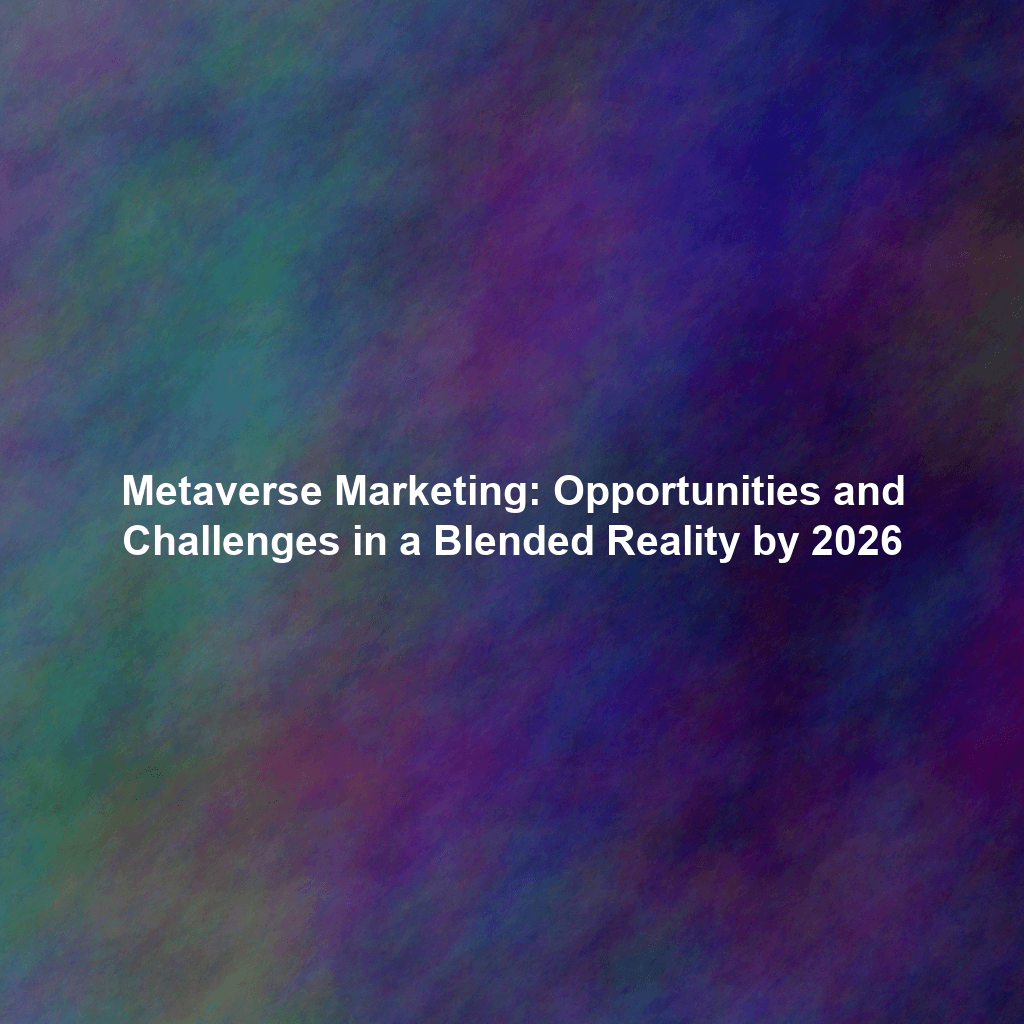The marketing landscape is constantly evolving, and by 2026, the metaverse promises to be a significant battleground for brands. This immersive, interconnected digital realm presents unprecedented opportunities to engage with consumers in entirely new ways. But, alongside the potential rewards come significant challenges related to accessibility, data privacy, and the critical need for authentic engagement. This article explores the potential of metaverse marketing in 2026, examining successful early adopter campaigns, emerging platforms, the types of experiences that resonate with users, and the hurdles brands must overcome to thrive in this blended reality.
The Untapped Potential: Metaverse Marketing in 2026
Imagine a world where consumers can virtually try on clothes before buying them online, attend live concerts from their living rooms, or collaborate on product design with brands in shared virtual spaces. This is the potential of the metaverse – a persistent, shared, 3D virtual world accessible through various devices, including virtual reality (VR) headsets, augmented reality (AR) apps, and even traditional computers and smartphones. By 2026, metaverse platforms will likely be more sophisticated, user-friendly, and interconnected, making them a prime location for innovative marketing campaigns.
Early Adopter Success Stories
Even in its early stages, metaverse marketing has seen some notable successes. Brands like Nike, with their Nikeland on Roblox, have created engaging virtual environments where users can play games, customize avatars, and even purchase digital Nike products. Gucci has also experimented with metaverse activations, offering virtual Gucci Garden experiences on platforms like Roblox and selling limited-edition digital fashion items. These early successes demonstrate the potential of the metaverse to drive brand awareness, generate revenue, and foster a sense of community.
Emerging Metaverse Platforms to Watch
While established platforms like Roblox and Fortnite are already popular metaverse destinations, several other platforms are emerging as potential marketing hubs. These include:
- Decentraland and The Sandbox: Blockchain-based virtual worlds that offer users ownership of virtual land and assets, enabling unique and decentralized marketing opportunities.
- Horizon Worlds (Meta): Meta’s ambitious metaverse platform aims to create immersive social experiences and is expected to become a major player in the space.
- Spatial: Focused on collaborative and creative experiences, Spatial is gaining traction as a platform for virtual art galleries, exhibitions, and meetings.
- Gaming Platforms: Beyond Fortnite and Roblox, other gaming platforms are incorporating metaverse elements, offering brands opportunities to reach specific demographics.
Experiences that Resonate: What Works in the Metaverse?
To succeed in the metaverse, brands need to move beyond traditional advertising and create truly engaging and valuable experiences for users. This means focusing on:
- Interactive Entertainment: Games, contests, virtual events, and other interactive experiences can draw users in and keep them engaged.
- Virtual Product Demonstrations: Allowing users to virtually try out products and services can be a powerful way to drive sales.
- Personalized Experiences: Using data to create personalized experiences that cater to individual user preferences.
- Community Building: Fostering a sense of community by creating virtual spaces where users can connect with each other and with the brand.
- Gamification: Integrating game mechanics like points, badges, and leaderboards to encourage engagement and reward participation.
Challenges and Considerations for Metaverse Marketing
Despite its potential, metaverse marketing also presents significant challenges that brands must address to avoid pitfalls and build sustainable, ethical engagement.
Accessibility and Digital Divide
Ensuring accessibility for all users is crucial. Currently, access to the metaverse is limited by the cost of VR headsets, reliable internet connectivity, and the digital skills required to navigate virtual environments. Brands must consider these limitations and develop strategies to reach a broader audience through alternative access points, such as mobile devices and web-based interfaces.
Data Privacy and Security
The metaverse generates vast amounts of user data, raising concerns about privacy and security. Brands must be transparent about how they collect, use, and protect user data and comply with relevant privacy regulations. Furthermore, they must implement robust security measures to prevent data breaches and protect users from malicious actors.
Authenticity and Avoiding “Marketing Gimmicks”
Consumers are increasingly skeptical of traditional advertising, and this skepticism extends to the metaverse. Brands need to avoid simply transplanting traditional marketing tactics into virtual environments and focus on creating authentic, valuable experiences that resonate with users. Transparency, genuine engagement, and a focus on community building are essential for building trust and credibility.
Measuring ROI and Attribution
Measuring the return on investment (ROI) of metaverse marketing campaigns can be challenging. Developing clear metrics and attribution models to track the impact of metaverse activities on brand awareness, sales, and customer loyalty is crucial for justifying investments and optimizing campaigns. This requires robust analytics tools and a deep understanding of user behavior within virtual environments.
Evolving Regulations and Legal Frameworks
The legal and regulatory landscape surrounding the metaverse is still evolving. Brands must stay informed about emerging regulations related to data privacy, intellectual property, and consumer protection to ensure compliance and avoid legal risks. This includes understanding the legal implications of virtual assets, NFTs, and other metaverse-specific technologies.
Building Meaningful Connections in Virtual Environments
Ultimately, successful metaverse marketing is about building meaningful connections with consumers in virtual environments. This requires a strategic approach that focuses on creating valuable experiences, fostering a sense of community, and respecting user privacy. By embracing authenticity, innovation, and ethical practices, brands can unlock the full potential of the metaverse and build lasting relationships with their target audiences.
Conclusion: Embracing the Metaverse with Strategy and Ethics
As we move closer to 2026, the metaverse is poised to become an increasingly important marketing channel. Brands that embrace this new frontier with a strategic and ethical approach will be well-positioned to thrive in this blended reality. By focusing on creating engaging experiences, prioritizing user privacy, and fostering genuine connections, marketers can unlock the vast potential of the metaverse and build a brighter future for brand engagement.
 Skip to content
Skip to content

